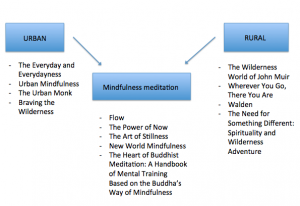My literature falls into three categories as shown in figure 1.
Figure 1. Literature categorized (insert photo)
All the literature I have chosen is based on mindfulness and some on the more urban side and others on the rural side. Mindfulness and meditation is an important part in today’s society as many people are in a battle with their health and wellbeing (Thera, 1962). Roots are set in Buddhism, however; there are many westerners such as Eckhart Tolle, Pico Iyer, Mihaly Csikzentimihalyi, Brené Brown, John Kabat-Zinn, and others that have taken the foundations of meditation and mindfulness to make it their own practice to not only help themselves but to help others as well. I seek to gain knowledge from some of the best meditation and mindfulness leaders and present my own findings through autoethnographic research. The following literature review will help me categorize best practices for meditation and mindfulness in rural and urban settings.
Csikzentimihalyi (1991) without mentioning mindfulness and meditation, provides the overall notion of what they might entail – Optimal experience. Optimal experience is based on the “ability to control what happens in consciousness moment by moment, each person has to achieve it on the basis of his own individual efforts and creativity” (Csikzentimihalyi, 1991). To create the optimal experience Tolle (1999) provides us with the notion of surrendering ourselves (our minds) to accept the now and appreciate what we have in life. An example of this was found in a story written by Iyer (2014), who travelled the world to find himself only to realize that finding himself lies within. Those who practice and write about mindfulness and meditation were on a similar path as Iyer, some found the practice to be helpful when dealing with a physical or mental illness just as those shared in the writings of McCown & Micozzi (2011). My personal experiences will coincide coincidentally with many examples I have found.
Stringer & McAvoy (1992) went out into a wilderness setting to find out what traits were discovered by participants to be spiritually beneficial. This study reiterates that the modern world “provides many reasons for disillusionment and despair; a troubled economy, high crime rates, a ravaged environment, the drug crises, child abuse, and war [to name a few]” (Stringer & McAvoy). Men such as Thoreau (1960) and Muir (1954) are well known wilderness philosophers and it took them to leave highly populated areas behind to realize true beauty in this world does not revolve around stuff. Rather, the two men travelled far into wilderness lands to find tranquility and peace within themselves and the surrounding areas. These examples are pulled together with the mindfulness work written by Kabat-Zinn (1994). A section in his book is titled “A What-Is-My-Way? Meditation” and in this section he discusses how we can only get what we want if we are fully there, we must ask the simple questions in order to make us think about what we truly desire (Kabat-Zinn, 1994). With this intention, he guides saying that we need to “remain open to not knowing, perhaps allowing yourself to come to a point of admitting” not knowing where you are or what exactly you’re doing (Kabat-Zinn, 1994). These notions can be reflected upon in the rural, however; other examples may prove that they can be reflected in urban areas as well.
Brown (2017), talks about the primal nature of belonging and how we must reconnect with ourselves in order to reconnect with others. She uses a qualitative grounded research theory whereby “the goal of grounded theory is to develop theories based on people’s lived experiences rather than proving or disproving existing theories” when it comes to belonging Brown (2017) asked: “What are people trying to achieve? What are they worried about?” I seek to delve into these questions for myself as I perform my autoethnography on mindfulness and meditation. These questions can be asked for those in rural areas and urban areas. What Shojai (2016) tries to achieve is the balance of belonging, demonstrating ten daily struggles some might have and providing ways of mitigation and happiness: dealing with stress, mastering time, having enough energy, not sleeping properly, stagnant lifestyle, having a negative self-image, lack of connection with nature, loneliness, and finding purpose in life. Brown and Shojai attempt to help those who are struggling but the real struggle is not knowing that there is a primary societal problem at hand for many.
Lefebvre & Levich (1987) discuss diversity and how it has never been well acknowledged because “today we see a worldwide tendency to uniformity” whereby we all have a common goal of fitting in. Should we all want to fit in somewhere? Or do we all want to be our authentic selves? How we can discover this through meditation and acknowledging our own selves. Kaplan (2010) discusses that we spend a lot of time waiting and often become impatient, what we can do in these moments is discover who we are, take the time for ourselves, to acknowledge that we are important in the morning while we wait for our coffee or for the bus. This notion can also go alongside competition and trying to beat someone else near you to the task at hand, whereby we can never be fast enough or good enough at a task (Kaplan, 2010). We might not know that it is okay and also difficult to let ourselves be present in a moment, to not have to hurry from one meeting or destination to the next.
The literature serves as a starting point for my research. My intent is to create a meditative practice around who I am and who I want to be. I will use the meditation application called Headspace everyday for two weeks, in and out of urban and rural areas. During this time I will write down how I am feeling whether it related to the literature or if it is a creative piece of my own. This study is meant for my own benefit so that one day I can benefit others in the field of healthy living and wellness.
Autoethnographic research refers to an “approach to research and writing that seeks to describe and systematically analyze (graphy) personal experience (auto) in order to understand cultural experience (ethno)” (Ellis, Adams, Bochner, 2011). This type of study is conducive for my research, as I believe it is closely related to social science rather than a hard science such as physics. Numbers do not have a say in how well one can understand and get to know themselves. This will be a journey for my self, to share with others, and hopefully aid in the process of creating self-awareness of ones-self. Meditation and mindfulness has been beneficial to me in the past and I know it will continue to be beneficial for my health and wellbeing in the future.

